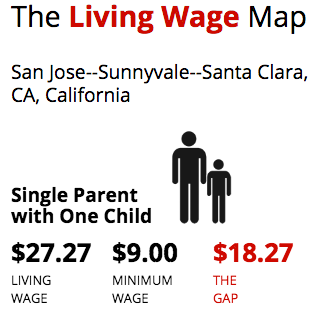The Living Wage in Your City Is Probably Higher Than You Think

By:
The "Fight for $15" operates under a straightforward premise: anybody who works should be able to survive on their wages.
 Fibonacci Blue - flic.kr
Fibonacci Blue - flic.kr
As uncontroversial as that sounds, the Fight for $15 has nevertheless encountered its fair share of opposition, either from economists who grimly predict that a $15 minimum wage will kill jobs, despite growing evidence to the contrary, or from commenters who argue that low-skill workers don't deserve anything more than a poverty wage.
However, while prominent voices continue to argue that $15 minimum wage goes too far, Massachusetts Institute of Technology’s Living Wage Calculator indicates that $15 an hour might might not go far enough, especially for single parents with small children.
In metropolitan areas like Seattle, which was one of the first major cities to raise its minimum wage to $15 in 2014, both adults in a family of four would need to make $16.29 an hour to cover the costs of basic needs and childcare. One adult with two children would need to make $29.99 an hour. And that is, of course, if that adult worked full-time and didn’t take any unpaid days.
 Living Wage Calculator - mit.edu
Living Wage Calculator - mit.edu
Created in 2004 by Dr. Amy K. Glasmeier, a professor in MIT’s Department of Urban Studies and Planning, the Living Wage Calculator uses expenditure data from specific geographic regions to add up the minimum costs of necessities like transportation, clothing, and food. Based on data collected from all 50 states in 2015, an average family with two adults and two children currently “needs to work nearly four full-time minimum-wage jobs (a 76-hour work week per working adult) to earn a living wage.”
The map even confronts the popular argument that residents of small towns and counties are less in need of a wage boost than workers in metropolitan areas. However, a quick search shows that even in a Kansas' Wyandotte County, which has a population of just 160,000, the minimum wage falls well short of the living wage.
 Living Wage Calculator - mit.edu
Living Wage Calculator - mit.edu
You can easily determine the living wage in your city or county by using the search function at the top of the Living Wage Calculator's Page.
In collaboration with Allen Carroll and the mapping software company Esri, Glasmeier recently made an interactive map that shows the gap between the minimum and living wages. Though Glasmeier told The Atlantic in 2015 that the map is meant to be a tool for both employers and employees, it also offers an indication of just how high the cost of living has become.
In San Jose, California — which was ranked by Forbes as the second-best city for jobs in 2016 — a single parent with one child would need to make $27.36 an hour. That’s $17.36 more than California’s minimum wage.
 Living Wage Map - esri.com
Living Wage Map - esri.com
On top of not being paid enough, many minimum-wage employees work part-time or what experts call “variable work schedules,” meaning the number of hours per week fluctuates. According to a 2014 study by the University of Chicago, 90 percent of food service workers were given an inconsistent number of hours each week, making it difficult to save money or plan for the future.
While the Fight for $15 was initiated by fast-food workers, the movement has grown to include a wider range of low-wage industries. In November, thousands of airport employees protested in Chicago and Newark. Home care assistants, adjunct professors, and janitors have also taken part in these demonstrations, indicating the need for decent wages isn’t exclusive to the service industry.
 Fibonacci Blue - flic.kr
Fibonacci Blue - flic.kr
Despite the progress that’s been made on the labor front under President Barack Obama, the gap between a minimum and living wage persists. And, with a fast-food executive who has openly opposed raising the minimum wage in President-elect Donald Trump’s cabinet, it’s unlikely that the federal minimum wage will increase in the next four years.
